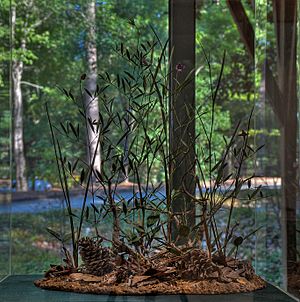Alabama leather flower facts for kids
Quick facts for kids Alabama leather flower |
|
|---|---|
| Conservation status | |
| Scientific classification |

The Clematis socialis is a very rare flowering plant. It belongs to the buttercup family. People often call it the Alabama leather flower. This plant naturally grows in Alabama and Georgia, but it's found in only five small areas. Its home is in great danger because of habitat destruction. This means its natural living spaces are being destroyed. Because it's so rare and threatened, the government has listed it as an endangered species.
Contents
Discovering the Alabama Leather Flower
This special plant was first found in 1980. It was growing next to a highway in St. Clair County, Alabama. Scientists then officially named it a new species in 1982. A few years later, a second, very tiny group of these plants was found in Cherokee County.
When no more plants were found after many searches, the plant was put on the endangered species list in 1986. This was done to protect it. By 2010, there were four groups of these plants in Alabama and one in Georgia. Four of these five groups seemed stable. However, two of them were very small, covering less than one acre each. Only two of the groups were protected by law.
What Does This Plant Look Like?
The Alabama leather flower is a perennial herb. This means it lives for many years. It grows from a special underground stem called a rhizome. The plant can grow up to half a meter tall. Unlike many other Clematis plants, it does not grow like a vine.
This plant often forms groups of stems. These stems all grow from the same underground rhizome. So, what looks like many separate plants is actually one plant with several clones connected by its roots. The leaves near the bottom are simple or have lobes. The leaves higher up might be divided into thin, pointed parts. The plant has one flower at the top of each stem. Its four purple-blue sepals form an urn shape with tips that spread out. It does not have petals. The flower can be up to 3 centimeters long. After flowering, it produces a fruit up to 2.5 centimeters long, including its hairy, long tip.
How the Plant Grows and Spreads
This plant rarely reproduces by making seeds. Instead, it mostly spreads by vegetative reproduction. This means new plants sprout from its underground rhizome. When the plant grows in the shade, it doesn't make many seeds.
The plant needs pollinators to help it make seeds. The best pollinator is a bee called Anthophora ursina. Another important pollinator is the bumblebee Bombus pennsylvanicus. This bumblebee is often the first to visit the flowers when they bloom early. Other insects that visit the plant include:
- Juvenal's duskywing (a butterfly)
- Snowberry clearwing (a moth)
- Eastern carpenter bee
Scientists think the plant might not get enough visits from pollinators. This means it doesn't make as many seeds as it could. Even though it mostly spreads by its roots, studies show it has a good amount of genetic diversity. This is surprising for a rare plant that mainly clones itself.
Where Does It Live?
The natural home of the Alabama leather flower is probably a mix of prairie and swampy forest areas. However, scientists are not sure exactly what types of habitats it prefers. This is because the plant is only found in places that have been changed by humans today.
The fact that it can live in disturbed areas suggests it might be used to places that naturally experience changes. For example, it might be adapted to habitats that often have wildfires. The plant grows better and makes more seeds in open areas where it gets at least some sun. It is often found growing with Phlox glaberrima. This common prairie flower is now seen as a sign that a place might be a good home for the Clematis.
Threats to the Alabama Leather Flower
The biggest danger to this plant is the destruction and damage of its home. Some groups of plants that used to exist have been destroyed. This happened because of things like building gas pipelines and fixing roads.
The very first group of plants found was in a very disturbed area. This land had been dug up to remove sick trees. It was next to a highway, where it had been affected by road work and landscaping. This included using herbicides, mowing, and erosion. This land was private property and was planned for houses. When the plant was added to the endangered species list, experts said it was "in great danger" and "very vulnerable."
All the groups of plants that exist today are facing competition from other plants. This means other plants are growing nearby and taking up space and resources. When the plant does manage to make seeds, mice often eat them. Climate change is also a possible threat. It could reduce the number of pollinators, which would make it harder for the plant to reproduce. As of 2010, the Alabama leather flower is still listed as an endangered species.
See Also
Images for kids
-
Clematis socialis exhibit at Callaway Gardens



